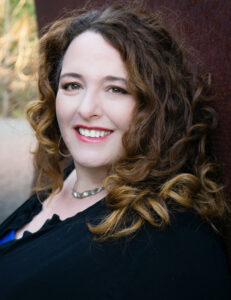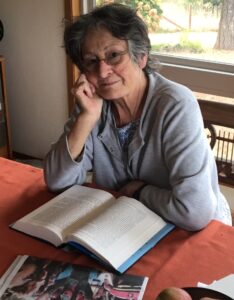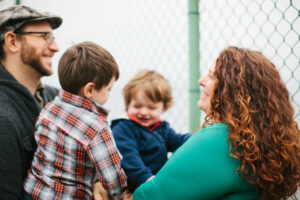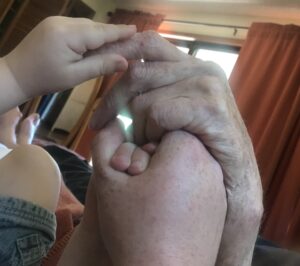 Hannah Lidman is based in Seattle and joined Hand in Hand during the Seattle Domestic Workers Ordinance campaign in 2018. Hannah is the mother to a 5 year old and 7 year old, and is a long-time advocate for child and family policy and currently a consultant for MomsRising.
Hannah Lidman is based in Seattle and joined Hand in Hand during the Seattle Domestic Workers Ordinance campaign in 2018. Hannah is the mother to a 5 year old and 7 year old, and is a long-time advocate for child and family policy and currently a consultant for MomsRising.
In this interview, Hannah reflects upon her experience as a sandwich caregiver.
—-
Hannah: In 2018 my mom was diagnosed with metastatic stage four lung cancer. My mom, Raven Lidman, was an incredible person. Right out of college she went to Delano and volunteered with the United Farm Workers and worked with Cesar Chavez and Dolores Huerta and was eventually sent to lead the grape boycotts in Toronto and NYC. After she became a lawyer, she fought for people and taught people how to become good lawyers and how to fight for people. She represented the first same-sex second parent adoption case in Washington State, which created a precedent for gay adoption that has never been challenged. She was amazing and I am so proud to be her daughter.

We were totally unprepared for what happened. When my mom was diagnosed I just dropped everything to support her care. I spent the five months and sixteen days that we had from her diagnosis to her passing, just driving, almost every day, 60 miles, to going to appointments with her, or being with her during her chemo and radiation, or making food or making sure she had time with her grandkids, or taking our last vacation together to the beach. Then she passed away, the day after my husband and I’s anniversary. It was a really incredible time together. And it was awful.
My family was very lucky to be in a financial position where I could just drop everything.
After my mom passed away, it took me months to recover emotionally. But I still had to take my kids to school every day, and feed them, and schedule playdates, and everything in my life that couldn’t stop because I am a parent.
And now we’re about to do it all again. We are about to go through a giant remodel where we are tearing down our garage and turn it into an apartment for my dad. We will become a multi-generational living household. Because my widowed father doesn’t want to be alone and I don’t want him to be.
I’m choosing to sandwich myself again.
Hand in Hand: Can you say more about that choice? Have you considered getting support for your dad’s long-term care?
Hannah: You know, we’ve become so ingrained in these non-communal ways of living that accepting outside help is such an anathema. Even to people like my family, who are very generous spirited. My parents just didn’t really want outside people involved in their care. They just wanted family, and we’re not a big family. It’s only me and my brother, and so they only wanted to lean on us. They didn’t want extra help.
It’s a problem for us all. It’s a nuclear fallout of a nuclear family concept. By perpetuating this idea of a small nuclear family, you create this nuclear fallout of people just limiting themselves. Even from people like my mom who come from a collective organizing community spirit, so many only want to lean on the immediate family.
 And when you’re the one, and you’re the mother of young kids— it’s so hard. It’s all on you.
And when you’re the one, and you’re the mother of young kids— it’s so hard. It’s all on you.
Still, I recognize how lucky I am to be in a stable financial position. The work I do to support women’s economic security is incredibly important work that I am extremely proud of, but it is not well paid. If it were not for my husband’s work, there is no way I could afford to just put my life and career on hold and stop working to just care for my family like I was able to.
Hand in Hand: What was the impact of this period of time on your career?
Hannah: The sad thing is that when my mom was diagnosed, I was realizing a career dream. At the time, I was furious about the level of investment that was going into technological solutions about things like, finding a taco anywhere, when there real problems that technology could help solve for parents. I was infuriated that there were these billion dollar unicorn companies for all sorts of problems for everyone and everything except no investment in solutions for moms. Absolutely nothing.
So I decided that I was going to build an app to connect parents with childcare providers – but one built with and for the early learning provider community too. I left my consulting and policy work and entered the female founder tech world and started to build a company. And it was incredible and terrifying and amazing.
By the time I was ready to work again, I had missed my window. Now there are ten or twelve different companies doing what I was aiming to do. I just missed my window.
Hand in Hand: How has your experience as a sandwich caregiver informed how you think about care and care infrastructure?

Hannah: Another friend put it in a really beautiful way to me recently. She was reflecting on the child care crisis. She said, “we just cannot keep relying on moms, to solve these problems individually, that we should be solving as a society together. Every family has to keep solving these problems from scratch when there are holistic solutions.”
If someone asks, and listens to women and parents about what they need we can create those solutions, but people have to be interested in what women need.
I have been hopeful recently this year in Washington State, this legislative session we’ve had the biggest investment in child care and in women’s economic security issues. And one of the reasons was the pandemic, but another reason is that the champions of those bills are moms, and the leadership of those committees are moms – people who experienced these problems first hand and know exactly what it is like to feel that squeeze. Years ago when I started in this work it was almost only older white men. It makes such a difference to see women, especially women of color in leadership roles who have the power to make change.
